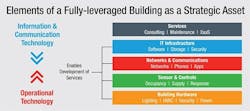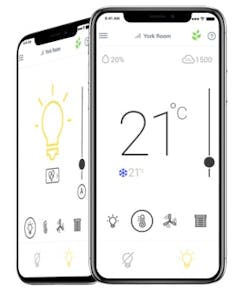Connected Buildings Save Money, Improve Tenant Experience
Office, educational, shopping, healthcare and other spaces have an increasing expectation from today’s occupants who want more connection points in buildings. One could argue that this idea was born from technological advancements in the Internet of Things (IoT).
They are right, but with one caveat—that building owners and managers today are driving the movement as well.
Owners are turning their locations into connected buildings, transitioning them from cost centers to strategic assets. Their main motivation is to benefit from the economic value of modernization, driven largely by data. Data helps building owners and managers capitalize on energy savings and enterprise-level reporting.
Businesses can use the data to improve building and business performance. The system also yields precise indoor location of people in the building. The data can be used to offer personal navigation on mobile apps and improve human connections.
Other important drivers include adding services and smarter energy management that entice business tenants.
An Argument for the Building Guys
There is an understanding that can come from a building hardware play, such as lights, HVAC, security or power. These systems require mapping an internal space to install the basic building components needed for connecting systems.
Upgrading can yield cost savings that generate an argument for IoT technologies. This is the advantage for the building guys.
By leveraging building systems to embed technologies, business cases for IoT can be modified to include energy savings. This adds a benefit of higher security and enterprise-level reporting. As such, owners and managers can compete with newer buildings, keeping current tenants or attracting larger profile tenants.
[Related: A Case for Future-Proofed Indoor Location Services]
The Technology Stack
The technology stack (see image below from Acuity Brands) shows the flow of operational and informational-communication technology. In the model is an intersection point. Service development is enabled through IT infrastructure beginning at the building hardware level, including the sensors and controls as well as the networks and communications levels.
A technology partner should have a well-established building partner or consulting arm to develop the right services. Thus, the situation of the current market, where partnerships and acquisitions are underway.
Thinking about location services for your building? Let lighting & BMS lead the way. Learn more.
Connected Buildings Go Beyond Smart Buildings
Advancements in IoT have created new ideas of how to advance building spaces with connected technologies. But the smart building concept has deep roots in the European and UK markets.
These regions have been using smarter buildings from the beginning. Four learnings that can be applied to the U.S. market include:
This provides economic benefits that result from data analytics enabled by IoT and are supported by the advancement of intelligent, connected buildings, cities and the smart grid.
2. Around 90 percent of our time is spent indoors,1 so connection is important.
For example, in healthcare, patients in rooms with brighter sunlight have a 22 percent lower need for pain medication. This can reduce healthcare costs.2 In the office, 55 percent of employees expect to work in a connected, smarter office by 2023. This could impact retention rates.3
End-to-end solutions use the BMS platform to power an IoT-enabled network funded by energy savings. The building gets greater energy efficiency by letting tenants remotely control cooling, heating, lighting and spaces. (Pictured: ECLYPSE Sky Ecosystem)
One example is using natural light via sunblind controls to reduce the need for man-made lighting.
4. ROI from connected spaces yields greater productivity from internal spaces.
The often-cited rule of 3-30-300 gives a per-square-foot breakdown of total occupancy costs. These figures, the brainchild of JLL, outline the typical distribution: $3 for utilities, $30 for rent, and $300 for employee/HR costs.
Occupant control of a space with Distech Controls
One way we offer occupants more control of their space is through improved energy efficiency via BMS controls and integrating technologies into a sensory network. The network maps indoor spaces through the BMS system, capturing data that is aggregated in the cloud.
Businesses can use the data to improve building and business performance. The system also yields precise indoor location of people in the building. The data can be used to offer personal navigation on mobile apps and improve human connections.
In short, benefits of connected buildings go beyond energy savings and enterprise-level reporting. By adding services and smarter energy management, businesses can create intelligent assets that save money and cater to the needs of owners and occupants.
About Martin Villeneuve:
Over the last 19 years, he served an integral role in developing the organization as a Controls Project Manager within the building automation industry. He can be reached for comment at [email protected].




